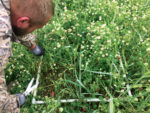Advertise Follow Us
Soil Health
Jackson, Wis., no-tiller Ross Bishop teaches local farmers and his suburban community about no-till’s benefits.
Read More
Prioritizing Soil Health to Protect Profitability for Generations to Come
The Crave family sees soil health as a key to reducing inputs, lowering machinery costs and creating more value-added products for long-term success and sustainability.
Read More
No-Till Newbie Reduces Erosion, Saves Trips Across the Field
Minnesota grower Dale Stevermer seeks to achieve environmental and economic sustainability by using no-till and covers.
Read More
What I've Learned from No-Tilling
No-Till, Cover Crops and Cattle Bring Revenue to Offset Tight Margins
Finding ways to extract more income from the same acres carves space for the next generation on this Illinois farm.
Read More
Profiting from a Diverse No-Till System
Missouri no-tiller Macauley Kincaid has seen yields of corn, soybeans, wheat and other cash crops improve after experiencing limited success with conventional farming.
Read More
[Podcast] Eliminating Herbicides with AI and Lasers
For this No-Till Farmer podcast, brought to you by Yetter Farm Equipment, we caught up with Paul Mikesell, founder and CEO of Carbon Robotics, a new company that is tackling weed control with a combination of artificial intelligence (AI) and lasers. This past year, in 2021, the company released its first production units of a machine called the LaserWeeder, which has the potential to eliminate the need for herbicides or tillage for weed control.
Read More











